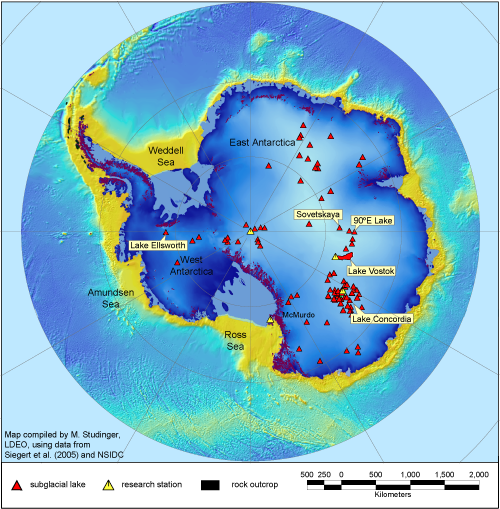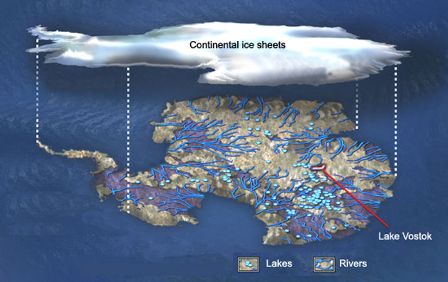It looks like you're using an Ad Blocker.
Please white-list or disable AboveTopSecret.com in your ad-blocking tool.
Thank you.
Some features of ATS will be disabled while you continue to use an ad-blocker.
4
share:
So Lake Vostok has been in the news big time. But who really owns it?
www.antarctica.gov.au...
It states... currently under international treaty.
Currently, war is epidemic in the fight for natural resources. There could be enormous untapped resources in Antartica and we're only scratching the surface. Give this some time, and I'm talking only a year or two, and Antarctica could be ground zero for future conflict. Other than the popular Lake Vostok, Antarctica's lakes are a breeding ground of exploration from a dozen of countries.
ETA: OK, I know the "International Treaty" as it stands now. I edited my post to look ahead at what might be the major issue in the next couple years. Oil people!

www.antarctica.gov.au...
It states... currently under international treaty.
There are few places in the world where there has never been war, where the environment is fully protected, and where scientific research has priority. But there is a whole continent like this - it is the land the Antarctic Treaty parties call '... a natural reserve, devoted to peace and science'.
At the southern end of our world, those who share the challenges of distance and cold to visit the ice-bound continent have developed a tradition of warm cooperation. Such cooperation, unique on this scale, is cemented by the Antarctic Treaty.
The Antarctic Treaty was signed in Washington on 1 December 1959 by the twelve nations that had been a ctive during the IGY (Argentina, Australia, Belgium, Chile, France, Japan, New Zealand, Norway, South Africa, United Kingdom, United States and USSR). The Treaty, which applies to the area south of 60° South latitude, is surprisingly short, but remarkably effective. Through this agreement, the countries active in Antarctica consult on the uses of a whole continent, with a commitment that it should not become the scene or object of international discord. In its fourteen articles the Treaty:
1. stipulates that Antarctica should be used exclusively for peaceful purposes, military activities, such as the establishment of military bases or weapons testing, are specifically prohibited;
2. guarantees continued freedom to conduct scientific research, as enjoyed during the IGY;
3. promotes international scientific cooperation including the exchange of research plans and personnel, and requires that results of research be made freely available
Currently, war is epidemic in the fight for natural resources. There could be enormous untapped resources in Antartica and we're only scratching the surface. Give this some time, and I'm talking only a year or two, and Antarctica could be ground zero for future conflict. Other than the popular Lake Vostok, Antarctica's lakes are a breeding ground of exploration from a dozen of countries.
ETA: OK, I know the "International Treaty" as it stands now. I edited my post to look ahead at what might be the major issue in the next couple years. Oil people!

edit on 6-2-2012 by UFO1414 because: (no reason given)
edit on Tue Feb 7 2012 by DontTreadOnMe because:
IMPORTANT: Using Content From Other Websites on ATS
the penguins.
No one country has legitimate jurisdiction over the landmass called "Antarctica"
No one country has legitimate jurisdiction over the landmass called "Antarctica"
reply to post by Glargod
No, not yet. Oil, natural gas, aliens... just wait until these untapped resources are confirmed. It's going to be a gong show folks.
No, not yet. Oil, natural gas, aliens... just wait until these untapped resources are confirmed. It's going to be a gong show folks.
edit on
6-2-2012 by UFO1414 because: (no reason given)
Doesnt Hitler still live there with all those alien nazi ufo?
Or is it the Nordic aliens that own it?
Or is it the Nordic aliens that own it?
It's under international treaty that no one owns it, just as the ocean or the moon. It is a place anyone can go with no restrictions, as long as you
have the means to get there.
reply to post by theubermensch
they can keep it It's friggen cold there
they can keep it It's friggen cold there
The climate of Antarctica is the coldest on the whole of Earth. Antarctica has the lowest naturally occurring temperature ever recorded on the ground on Earth: −89.2 °C (−128.6 °F) at Vostok Station.[1] It is also extremely dry (technically a desert), averaging 166 mm (6.5 in) of precipitation per year. Even so, on most parts of the continent the snow rarely melts and is eventually compressed to become the glacial ice that makes up the ice sheet. Weather fronts rarely penetrate far into the continent. Most of Antarctica has an ice cap climate (Köppen EF) with very cold, generally extremely dry weather throughout the year and no month averaging above 0 °C (32 °F). Some fringe coastal areas have a polar climate (Köppen ET) with a short summer averaging above freezing, and much higher precipitation
Yes, correct... Your op basically explains it all... Nobody owns it and it is for any country to use for peaceful scientific research...
If I'm not mistaken I think Australia has a pretty good claim to it, at least quite a lot of it, Chile and New Zealand too though. Whoever controls
antarctica will be loaded with resources when some of it melts....It will be a big issue who has control of it though, big big issue in the future,
hopefully we can all be civil about it.
Originally posted by sir_slide
If I'm not mistaken I think Australia has a pretty good claim to it, at least quite a lot of it, Chile and New Zealand too though. Whoever controls antarctica will be loaded with resources when some of it melts....It will be a big issue who has control of it though, big big issue in the future, hopefully we can all be civil about it.
Well we are known as a Civil Race when it comes to resources
so shouldnt be an issue
Man has made laws saying they own parts of the earth but in reality it is not his to possess. Legally noone owns antartica but nations have made
agreements on rules and regulations governing it's use.
reply to post by GonzoSinister
ahahha wishful thinking I guess
If it does melt in the future though, as in land appears people will seriously want to get their hands on it.....let's just hope ey
ahahha wishful thinking I guess
If it does melt in the future though, as in land appears people will seriously want to get their hands on it.....let's just hope ey
Originally posted by jta79
Yes, correct... Your op basically explains it all... Nobody owns it and it is for any country to use for peaceful scientific research...
Until everyone wants the one toy they find....won't see much *sharing* if it comes to something extremely valuable.
No one 'owns' it, but several countries have 'claimed' parts with Australia holding the largest claim (42%), and most of these claims are
internationally recognised.... to a point (The Brits, Argentina and Chile are having a bit of a scuffle over the pointy end though). Of course the
United States and Russia are both attempting to claim the unclaimed part as shown below but as of yet no one’s listening.

Lake Vostok is actually located in the Australian portion, which being Australian myself makes me a little pissed off, and only goes to show how weak these claims really are (or how incompetent the Australian government really is).
Some people just can't leave 'well enough' alone.....


Lake Vostok is actually located in the Australian portion, which being Australian myself makes me a little pissed off, and only goes to show how weak these claims really are (or how incompetent the Australian government really is).
Some people just can't leave 'well enough' alone.....

edit on 6/2/2012 by 1littlewolf because: (no reason given)
It's still mildly surprising to me that all these nations were willing to agree to such an impartial resolution for Antarctica. Given how
rapaciously we've sought out resources, I've always found this treaty odd and had a difficult time believing it would stand the test of time.
I'm glad that it has though.
I'm glad that it has though.
new topics
-
Awesome Dip Recipe
Food and Cooking: 4 minutes ago -
Vladimir Putin's speech at the meeting of the CSTO Collective Security Council
World War Three: 13 minutes ago -
Traveling the world with no passport
Social Issues and Civil Unrest: 4 hours ago -
Happy Thanksgiving to ATS
General Chit Chat: 8 hours ago
top topics
-
Simple Thanksgiving
Food and Cooking: 14 hours ago, 15 flags -
Happy Thanksgiving to ATS
General Chit Chat: 8 hours ago, 7 flags -
Traveling the world with no passport
Social Issues and Civil Unrest: 4 hours ago, 5 flags -
Vladimir Putin's speech at the meeting of the CSTO Collective Security Council
World War Three: 13 minutes ago, 0 flags -
Awesome Dip Recipe
Food and Cooking: 4 minutes ago, 0 flags
active topics
-
Mind Blowing Cave under someones land
Fragile Earth • 20 • : Astrocometus -
Awesome Dip Recipe
Food and Cooking • 0 • : Flyingclaydisk -
Vladimir Putin's speech at the meeting of the CSTO Collective Security Council
World War Three • 1 • : RussianTroll -
Happy Thanksgiving to ATS
General Chit Chat • 5 • : gort69 -
Inca stone masonry at Sacsayhuaman, Ollantaytambo and the Sun Temple
Ancient & Lost Civilizations • 21 • : Astrocometus -
Simple Thanksgiving
Food and Cooking • 30 • : Flyingclaydisk -
A Mysterious Orb filmed over NYC by local news
Aliens and UFOs • 27 • : Lazy88 -
Traveling the world with no passport
Social Issues and Civil Unrest • 4 • : Popoll -
Petition Calling for General Election at 564,016 and rising Fast
Political Issues • 107 • : gortex -
I thought Trump was the existential threat?
World War Three • 116 • : andy06shake
4
